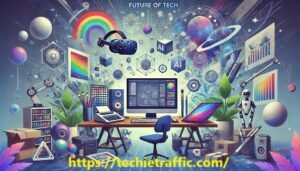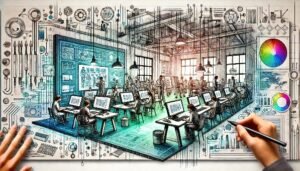The world of digital art is experiencing a massive transformation, thanks to the emergence of artificial intelligence (AI) tools. Among the most exciting advancements is animated drawing AI, which is making waves in the creative industry. These innovative AI systems are allowing artists to create stunning animations with ease, pushing the boundaries of imagination, and enhancing the efficiency of the creative process. In this article, we’ll explore animated drawing AI, its benefits, the technology behind it, and its potential impact on digital art.
What is Animated Drawing AI?
Animated drawing AI refers to the use of machine learning algorithms and artificial intelligence to assist or fully automate the creation of animated drawings and illustrations. This technology is used to generate or enhance animated content through tools that can mimic human-like drawing techniques, understand style preferences, and even predict motion in animated sequences.
Traditionally, creating animated drawings involved significant skill, time, and effort. Artists had to manually sketch and animate each frame, sometimes spending weeks or even months to complete a single project. With the introduction of animated drawing AI, artists now have the ability to accelerate this process while maintaining high levels of creativity and visual appeal.
How Does Animated Drawing AI Work?
Animated drawing AI uses a combination of deep learning, neural networks, and image recognition to generate and animate images. These systems are trained on vast datasets containing millions of images, which allows them to recognize patterns, styles, and motions. Here’s how it generally works:
-
Data Training: The AI is trained on a large dataset of animated images, drawings, and video frames. It learns how objects are drawn, how they move, and how animation principles work.
-
Image Generation: Once trained, the AI can generate initial static or dynamic images based on user input. The user might provide a sketch or rough draft, and the AI refines it by applying styles, textures, and motion elements.
-
Animation Process: After creating the initial drawings, the AI can then apply animation techniques, such as tweening (the process of generating intermediate frames between two images), motion paths, or even lip-syncing.
-
Finalization: Artists can then fine-tune the animations using the AI-generated content as a base. While the AI automates the heavy lifting, the artist still has control over the final result, making it a powerful tool for collaboration between human creativity and machine efficiency.
Benefits of Animated Drawing AI

Animated drawing AI offers numerous advantages, especially for artists, animators, and designers who need to produce high-quality content efficiently. Here are some key benefits:
1. Time Efficiency
Creating traditional animations can be an extremely time-consuming process. With AI-powered tools, artists can significantly reduce the time spent on tasks like sketching, inking, and tweening, enabling them to complete projects faster.
2. Cost-Effective
Hiring a team of animators or purchasing expensive software licenses can be costly. Animated drawing AI tools offer a more affordable alternative, making high-quality animation accessible to independent artists, small studios, and even hobbyists.
3. Improved Creativity
By automating repetitive tasks, artists have more time and energy to focus on the creative aspects of their work, such as designing characters, storyboarding, and experimenting with new techniques.
4. Accessibility
AI-powered tools open the door for beginners and non-artists to experiment with animation. Even without years of experience, anyone can use AI to create animations with minimal training, lowering the entry barriers to animation.
5. Style Flexibility
AI tools often come with the ability to mimic different artistic styles, from realistic to cartoonish. Artists can experiment with various looks, styles, and techniques, expanding their creative possibilities.
Applications of Animated Drawing AI
The uses of animated drawing AI are not limited to just entertainment. Here are some of the key applications:
1. Film and Television
Animated drawing AI can be used in film and TV animation, where speed and quality are essential. AI tools help to create character designs, backgrounds, and even full-length animated scenes.
2. Video Games
In the gaming industry, animated drawing AI is used to design character animations, backgrounds, and environments. This tool can help reduce production times and costs for indie developers and larger studios alike.
3. Advertising
Companies use animated drawing AI for creating dynamic and engaging advertisements. With AI, they can quickly produce animated sequences for social media, websites, and TV spots.
4. Social Media Content
Social media influencers and content creators can leverage animated drawing AI to enhance their posts, stories, and videos, adding a unique flair to their content without requiring professional animation skills.
5. Educational Content
AI-driven animated illustrations can be used in e-learning, offering a more engaging and interactive way of presenting lessons or tutorials through visual storytelling.
Popular Animated Drawing AI Tools
| Tool Name | Description | Key Features |
|---|---|---|
| DeepMotion | AI-powered animation tool focused on character motion capture. | Motion capture, automatic animation creation. |
| Runway ML | AI platform with tools for video, image, and animation editing. | Video generation, object tracking, image synthesis. |
| Toonify | AI tool for transforming images into cartoon-style animations. | Cartoon-style transformation, face mapping. |
| Artbreeder | AI art tool that allows users to blend and modify images. | Style mixing, face and portrait generation. |
| DoodleMorph | AI that turns sketches into animated drawings. | Transforming doodles into 3D animations. |
Step-by-Step Guide to Using Animated Drawing AI
Step 1: Choose Your Tool
Select an animated drawing AI tool that fits your needs and budget. Many AI tools offer free trials, so you can experiment before committing.
Step 2: Create Your Base Drawing
Start by creating a simple sketch or upload an image you’ve already drawn. Some tools allow you to draw directly in the interface.
Step 3: Let the AI Work Its Magic
Once your base image is ready, allow the AI to process and animate the drawing. The tool will apply motion, styles, and other effects to bring your art to life.
Step 4: Customize Your Animation
You can tweak the animations, adjust frames, add additional effects, or modify the style to suit your vision.
Step 5: Export and Share
Once you’re satisfied with the result, export your animation. Most tools allow you to export in various formats such as GIF, MP4, or MOV.
Challenges and Limitations

While animated drawing AI offers many benefits, it is not without its challenges:
1. Quality Control
AI may not always produce animations that match the artist’s original vision, and manual adjustments may be necessary.
2. Over-Reliance on AI
While AI can help speed up the process, artists may become overly reliant on the technology and lose some creative control.
3. Limited Understanding of Complex Human Emotions
AI-generated animations can sometimes fall short when it comes to conveying complex emotions or subtle facial expressions.
4. Cost of Advanced Tools
Some of the more powerful animated drawing AI tools can be expensive, putting them out of reach for some individuals or smaller studios.
The Future of Animated Drawing AI
The future of animated drawing AI is incredibly promising. As technology continues to advance, we can expect AI tools to become more intuitive and capable of generating highly detailed animations with minimal input. Here are a few trends to watch for:
1. Enhanced Realism
As AI improves, we can expect animations to become more realistic, with better representation of movement, lighting, and textures.
2. Greater Customization
Future tools may offer even more customization options, allowing artists to fine-tune animations with greater control.
3. More Integrations
AI tools will likely be integrated into more traditional animation software, streamlining the process for artists and animators.
4. AI-Assisted Storytelling
AI could potentially help in the creation of entire stories, suggesting plot twists, characters, and even dialogue based on user input.
Conclusion
Animated drawing AI is transforming the way digital artists approach animation. By simplifying and speeding up the creative process, AI tools are empowering artists to focus on the more creative and expressive aspects of their work. While the technology still has room to grow, it’s clear that animated drawing is here to stay, and its influence on the digital art world will only increase in the years to come.
As AI continues to evolve, it’s exciting to think about how this technology will continue to shape the future of art, animation, and storytelling.
Read More: Remaker AI Online Free: Everything You Need to Know About Using AI for Free


